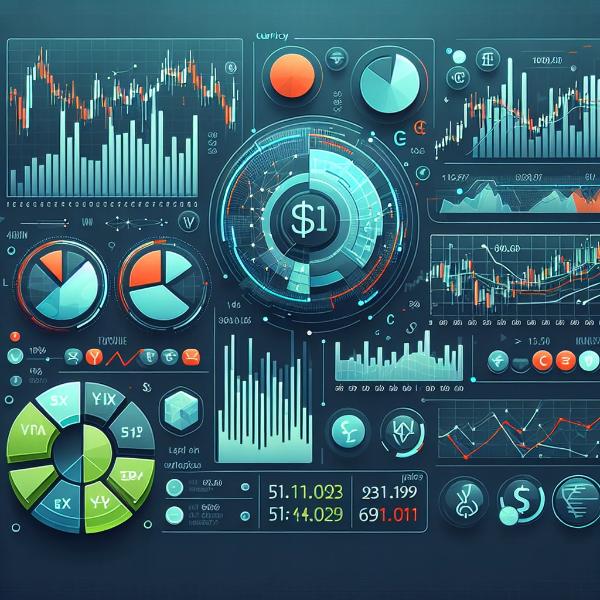Steps to Trade Forex: A Comprehensive Guide for Beginners

Are you interested in trading Forex but don’t know where to start?
Look no further!
Our comprehensive guide is designed specifically for beginners like you who want to learn how to trade Forex successfully.
With step-by-step instructions and expert tips, you’ll gain the knowledge and confidence needed to navigate the Forex market.
Here’s what you’ll learn:
- The basics of Forex trading
- How to choose a reliable broker
- Understanding currency pairs
- Reading Forex charts
- Implementing effective trading strategies
- Managing risk and maximizing profits
Don’t miss out on this opportunity to start your Forex trading journey on the right foot.
Get your copy of “Steps to Trade Forex: A Comprehensive Guide for Beginners” today and unlock the potential of Forex trading!
Understanding the Basics
Before diving into the world of forex trading, it is essential to understand the basics. This section will provide you with a solid foundation to build upon as you embark on your trading journey.
What is Forex?
Forex, short for foreign exchange, is the global market where currencies are traded. It is the largest and most liquid financial market in the world, with an average daily trading volume of $5 trillion. Forex trading involves buying one currency and selling another simultaneously, with the aim of profiting from the fluctuations in exchange rates.
Market Participants
The forex market is comprised of various participants, including central banks, commercial banks, hedge funds, multinational corporations, and retail traders. Each participant plays a unique role in shaping the market dynamics, and their actions can have a significant impact on currency prices.
Major Currency Pairs
Currencies are traded in pairs, with the most actively traded pairs known as major currency pairs. These pairs involve the US dollar (USD) and another major currency, such as the euro (EUR), British pound (GBP), Japanese yen (JPY), Swiss franc (CHF), Canadian dollar (CAD), or Australian dollar (AUD).
Understanding Currency Quotes
Currency quotes consist of two prices: the bid price and the ask price. The bid price represents the price at which you can sell the base currency, while the ask price represents the price at which you can buy the base currency. The difference between the bid and ask price is known as the spread.
Factors Affecting Exchange Rates
Exchange rates are influenced by various factors, including economic indicators, geopolitical events, central bank policies, and market sentiment. Understanding these factors and their impact on currency prices is crucial for successful forex trading.
Risk Management
Forex trading involves risks, and it is essential to have a solid risk management strategy in place. This includes setting stop-loss orders, using proper position sizing, and diversifying your trades to minimize potential losses.
Conclusion
Understanding the basics of forex trading is crucial for beginners. By grasping the concepts of forex, market participants, currency pairs, currency quotes, exchange rates, and risk management, you will be well-equipped to navigate the exciting world of forex trading.
Key Concepts and Terminology
1. Currency Pair: In forex trading, a currency pair represents the exchange rate between two currencies. It consists of a base currency and a quote currency, where the base currency is the first currency listed and the quote currency is the second currency listed.
2. Pips: Pips, short for “percentage in point,” are the smallest unit of measurement in forex trading. They represent the change in the exchange rate for a currency pair and are usually measured to the fourth decimal place.
3. Bid and Ask Price: The bid price is the price at which the market is willing to buy a currency pair, while the ask price is the price at which the market is willing to sell a currency pair. The difference between the bid and ask price is called the spread.
4. Leverage: Leverage allows traders to control larger positions in the market with a smaller amount of capital. It is expressed as a ratio, such as 1:100, and enables traders to amplify potential profits, but also increases the risk of losses.
5. Margin: Margin is the amount of money required to open and maintain a leveraged position in the forex market. It is a percentage of the total position size and acts as a collateral for potential losses.
6. Stop-Loss Order: A stop-loss order is an order placed by a trader to automatically close a position when the market reaches a certain price level. It is used to limit potential losses and protect against adverse market movements.
7. Take-Profit Order: A take-profit order is an order placed by a trader to automatically close a position when the market reaches a certain price level. It is used to lock in profits and exit a trade at a predetermined target.
8. Margin Call: A margin call occurs when the account equity falls below the required margin level. It is a notification from the broker to deposit additional funds or close positions to meet the margin requirements and avoid the liquidation of positions.
9. Fundamental Analysis: Fundamental analysis involves analyzing economic, social, and political factors that may affect the value of a currency. It includes studying economic indicators, central bank decisions, and geopolitical events to make trading decisions.
10. Technical Analysis: Technical analysis involves analyzing historical price data and using various tools and indicators to identify patterns and trends in the market. It helps traders predict future price movements and make informed trading decisions.
11. Risk Management: Risk management refers to the strategies and techniques used to minimize potential losses and protect capital in forex trading. It includes setting stop-loss orders, using proper position sizing, and diversifying the portfolio.
12. Liquidity: Liquidity refers to the ease with which an asset can be bought or sold without causing significant price movements. In forex trading, high liquidity allows traders to enter and exit positions at any time without impacting the market.
13. Volatility: Volatility measures the rate at which the price of a currency pair fluctuates. High volatility can provide trading opportunities but also increases the risk of sudden price movements and potential losses.
14. Demo Account: A demo account is a practice account offered by brokers that allows traders to trade with virtual money. It is used to test trading strategies, practice trading skills, and familiarize oneself with the trading platform.
15. Real Account: A real account is a live trading account where traders use real money to execute trades in the forex market. It involves real financial risk and potential profits or losses.
16. Economic Calendar: An economic calendar is a tool that provides information about upcoming economic events, such as economic indicators releases, central bank meetings, and political announcements. Traders use it to stay informed about potential market-moving events.
17. Order Types: Order types are instructions given by traders to execute trades in the forex market. Common order types include market orders, limit orders, stop orders, and trailing stop orders.
18. Trading Platform: A trading platform is a software or online platform provided by brokers that allows traders to access the forex market, execute trades, analyze charts, and manage their trading accounts.
19. Candlestick Chart: A candlestick chart is a type of chart used in technical analysis that displays the open, high, low, and close prices of a currency pair for a specific time period. It helps traders identify patterns and trends in the market.
20. Trend: A trend refers to the general direction in which the price of a currency pair is moving over a certain period of time. It can be an uptrend (rising prices), a downtrend (falling prices), or a sideways trend (range-bound prices).
Choosing a Forex Broker
When it comes to trading forex, choosing the right broker is crucial for your success. A forex broker acts as an intermediary between you and the forex market, executing your trades and providing you with access to various trading tools and resources. Here are some factors to consider when selecting a forex broker:
| Regulation and Licensing: | Ensure that the broker you choose is regulated and licensed by a reputable financial authority. This will help protect your funds and ensure fair trading practices. |
| Trading Platform: | Check if the broker offers a user-friendly and reliable trading platform. It should have advanced charting tools, real-time market data, and a variety of order types to suit your trading style. |
| Account Types: | Consider the different account types offered by the broker. Look for accounts that match your trading needs, such as standard accounts for beginners or ECN accounts for advanced traders. |
| Spreads and Commissions: | Compare the spreads and commissions charged by different brokers. Lower spreads and commissions can help reduce your trading costs and increase your profits. |
| Customer Support: | Make sure the broker provides reliable customer support. They should offer multiple channels of communication, such as phone, email, and live chat, and be responsive to your inquiries. |
| Education and Resources: | Look for brokers that offer educational resources and tools to help you improve your trading skills. This can include tutorials, webinars, market analysis, and trading signals. |
| Deposit and Withdrawal Options: | Check the deposit and withdrawal options provided by the broker. It should offer convenient and secure methods for funding your account and withdrawing your profits. |
| Reputation and Reviews: | Research the broker’s reputation and read reviews from other traders. This will give you an idea of their track record and whether they are trustworthy and reliable. |
Take your time to research and compare different forex brokers before making a decision. Remember, the right broker can greatly enhance your trading experience and increase your chances of success in the forex market.
Developing a Trading Strategy
Developing a trading strategy is a crucial step in becoming a successful forex trader. A trading strategy is a set of rules and guidelines that a trader follows to make informed decisions about when to enter and exit trades.
Here are some key steps to consider when developing your trading strategy:
1. Define your goals: Before you start trading, it’s important to have a clear understanding of what you want to achieve. Are you looking to make a consistent income or are you trading for long-term wealth accumulation? Defining your goals will help you determine the appropriate trading approach.
2. Determine your risk tolerance: Every trader has a different risk tolerance level. Some are comfortable taking high risks for potentially high rewards, while others prefer a more conservative approach. Assess your risk tolerance and develop a strategy that aligns with your comfort level.
3. Choose your trading style: There are various trading styles, such as day trading, swing trading, and position trading. Each style requires a different approach and time commitment. Consider your available time, resources, and personality traits to determine which style suits you best.
4. Analyze the market: To develop an effective trading strategy, you need to understand the market dynamics. Conduct thorough market analysis using technical and fundamental analysis techniques. This will help you identify trends, patterns, and potential trading opportunities.
5. Set entry and exit rules: A trading strategy should include specific rules for entering and exiting trades. Determine the criteria for entering a trade, such as specific technical indicators or price levels. Similarly, define the conditions for exiting a trade, including profit targets and stop-loss levels.
6. Test and refine your strategy: Once you have developed your trading strategy, it’s important to test it in a simulated trading environment. This will help you identify any flaws or areas for improvement. Refine your strategy based on the results of your testing.
7. Stick to your strategy: Consistency is key in forex trading. Once you have a well-defined strategy, stick to it and avoid making impulsive decisions based on emotions or market noise. Trust in your strategy and give it time to yield results.
Remember, developing a trading strategy takes time and practice. It’s important to continuously monitor and adjust your strategy as market conditions change. By following a well-defined strategy, you can increase your chances of success in the forex market.
Setting Financial Goals
Setting financial goals is an essential step in achieving financial success. Whether you are a beginner or an experienced trader, having clear and realistic financial goals can help guide your trading decisions and keep you motivated.
When setting financial goals, it is important to consider both short-term and long-term objectives. Short-term goals can be achieved within a few months or a year, while long-term goals may take several years or even decades to accomplish.
Start by assessing your current financial situation and determining what you want to achieve. Do you want to save for a down payment on a house, pay off debt, or build a retirement fund? Once you have identified your goals, you can create a plan to reach them.
Make sure your goals are specific, measurable, achievable, relevant, and time-bound (SMART). For example, instead of saying “I want to make more money,” a SMART goal would be “I want to increase my monthly income by 20% within the next six months by trading Forex.”
Break down your goals into smaller, actionable steps. This will make them more manageable and help you stay focused. For example, if your goal is to save $10,000 for a vacation, you can break it down into saving $1,000 per month for the next ten months.
Regularly review and adjust your goals as needed. Financial circumstances and priorities can change over time, so it is important to stay flexible and adapt your goals accordingly. Celebrate your achievements along the way to stay motivated and inspired.
Remember, setting financial goals is not just about the end result, but also about the journey. Enjoy the process of learning, growing, and improving your financial situation. With dedication, discipline, and a clear plan, you can achieve your financial goals and create a brighter future for yourself.
Analyzing Market Trends
When it comes to trading forex, analyzing market trends is crucial for making informed decisions. By understanding the direction in which the market is moving, traders can identify potential opportunities and minimize risks.
Technical Analysis: One popular method for analyzing market trends is through technical analysis. This approach involves studying historical price data, charts, and indicators to identify patterns and trends. Traders use various tools such as moving averages, support and resistance levels, and trend lines to determine the overall direction of the market.
Fundamental Analysis: Another important aspect of analyzing market trends is fundamental analysis. This involves examining economic indicators, news releases, and geopolitical events that can impact the forex market. By staying informed about factors such as interest rates, inflation, and political stability, traders can anticipate market movements and adjust their strategies accordingly.
Sentiment Analysis: In addition to technical and fundamental analysis, sentiment analysis plays a significant role in analyzing market trends. This approach involves gauging the overall sentiment or mood of traders towards a particular currency pair. Traders can use tools such as market sentiment indicators, news sentiment analysis, and social media sentiment analysis to assess market sentiment and make informed trading decisions.
Combining Analysis Methods: While each analysis method has its strengths, many traders combine multiple approaches to get a comprehensive view of market trends. By combining technical, fundamental, and sentiment analysis, traders can gain a deeper understanding of the market and increase their chances of success.
Remember, analyzing market trends is an ongoing process. It requires continuous monitoring, learning, and adapting to the ever-changing forex market. By staying informed and using a combination of analysis methods, traders can improve their trading skills and increase their profitability.
Risk Management Techniques
When trading Forex, it is important to have a solid risk management strategy in place. This will help you minimize potential losses and protect your capital. Here are some effective risk management techniques to consider:
1. Set Stop Loss Orders: A stop loss order is an instruction to close a trade at a predetermined price level. By setting a stop loss order, you can limit your potential losses if the market moves against you.
2. Use Proper Position Sizing: Determining the appropriate position size for each trade is crucial. It is recommended to risk only a small percentage of your trading capital on each trade, typically no more than 2-3%.
3. Diversify Your Portfolio: Avoid putting all your eggs in one basket by diversifying your trading portfolio. This means trading different currency pairs and possibly other financial instruments to spread out your risk.
4. Stay Informed: Keep up-to-date with market news and events that can impact the Forex market. This will help you make informed trading decisions and manage your risk effectively.
5. Use Trailing Stop Loss Orders: Trailing stop loss orders can be a useful tool to protect your profits. This order automatically adjusts your stop loss level as the market moves in your favor, locking in profits while still allowing for potential upside.
6. Practice Proper Money Management: Money management is crucial in Forex trading. This includes setting realistic profit targets, not risking too much on a single trade, and avoiding emotional decision-making.
7. Use Risk-to-Reward Ratio: Before entering a trade, calculate the risk-to-reward ratio. This ratio compares the potential profit of a trade to the potential loss. It is recommended to only take trades with a favorable risk-to-reward ratio.
8. Keep Emotions in Check: Emotions can cloud judgment and lead to impulsive trading decisions. It is important to stay disciplined and stick to your trading plan, even in the face of market volatility.
9. Regularly Review and Adjust: Continuously monitor your trading performance and adjust your risk management strategy as needed. This will help you adapt to changing market conditions and improve your overall trading results.
By implementing these risk management techniques, you can increase your chances of success in Forex trading while minimizing potential losses. Remember, trading Forex involves risk, and it is important to approach it with a disciplined and well-thought-out strategy.
Executing Trades and Monitoring Performance
Once you have learned the basics of forex trading and have developed a trading strategy, it is time to start executing trades and monitoring your performance. Here are some important steps to follow:
- Choose a reliable forex broker: Before you can start trading, you need to find a reputable forex broker. Look for a broker that offers competitive spreads, a user-friendly trading platform, and reliable customer support.
- Open a trading account: Once you have selected a broker, you will need to open a trading account. This typically involves providing some personal information and funding your account with an initial deposit.
- Analyze the market: Before entering a trade, it is important to analyze the market and identify potential trading opportunities. This can be done through technical analysis, fundamental analysis, or a combination of both.
- Place your trade: Once you have identified a trading opportunity, you can place your trade. This involves selecting the currency pair you want to trade, specifying the trade size, and choosing whether to buy or sell.
- Set stop-loss and take-profit levels: To manage your risk, it is important to set stop-loss and take-profit levels for each trade. A stop-loss order will automatically close your trade if the market moves against you, while a take-profit order will close your trade when it reaches a certain profit level.
- Monitor your trade: After placing a trade, it is important to monitor its performance. Keep an eye on the market and be prepared to adjust your stop-loss and take-profit levels if necessary.
- Review your performance: Regularly review your trading performance to identify strengths and weaknesses. This can help you refine your trading strategy and improve your overall profitability.
- Manage your emotions: Trading can be an emotional rollercoaster, but it is important to stay disciplined and stick to your trading plan. Avoid making impulsive decisions based on fear or greed.
By following these steps and continuously learning and improving, you can become a successful forex trader. Remember, trading forex involves risk, so it is important to trade responsibly and only risk what you can afford to lose.
Question-Answer:
What is “Steps to Trade Forex A Comprehensive Guide for Beginners” about?
“Steps to Trade Forex A Comprehensive Guide for Beginners” is a book that provides a comprehensive guide for beginners who want to learn how to trade forex. It covers the basic concepts of forex trading, including how to read charts, analyze market trends, and make informed trading decisions.
Who is the author of “Steps to Trade Forex A Comprehensive Guide for Beginners”?
The author of “Steps to Trade Forex A Comprehensive Guide for Beginners” is an experienced forex trader who has successfully traded in the forex market for many years. They have compiled their knowledge and expertise into this book to help beginners navigate the world of forex trading.
Is “Steps to Trade Forex A Comprehensive Guide for Beginners” suitable for someone with no prior knowledge of forex trading?
Yes, “Steps to Trade Forex A Comprehensive Guide for Beginners” is specifically designed for individuals with no prior knowledge of forex trading. It starts with the basics and gradually progresses to more advanced topics, making it easy for beginners to understand and follow along.
What topics are covered in “Steps to Trade Forex A Comprehensive Guide for Beginners”?
“Steps to Trade Forex A Comprehensive Guide for Beginners” covers a wide range of topics related to forex trading. Some of the topics covered include understanding forex markets, reading and interpreting charts, analyzing market trends, developing trading strategies, managing risk, and executing trades.
Is “Steps to Trade Forex A Comprehensive Guide for Beginners” suitable for experienced traders as well?
While “Steps to Trade Forex A Comprehensive Guide for Beginners” is primarily aimed at beginners, experienced traders can also benefit from the book. It provides a comprehensive overview of forex trading and covers some advanced topics that can help experienced traders refine their strategies and improve their trading skills.
What is “Steps to Trade Forex A Comprehensive Guide for Beginners” about?
“Steps to Trade Forex A Comprehensive Guide for Beginners” is a comprehensive guide that provides step-by-step instructions on how to trade forex for beginners. It covers all the essential aspects of forex trading, including understanding the forex market, analyzing charts, executing trades, managing risk, and developing a trading strategy.
Who is the author of “Steps to Trade Forex A Comprehensive Guide for Beginners”?
The author of “Steps to Trade Forex A Comprehensive Guide for Beginners” is an experienced forex trader who has been trading in the forex market for many years. The author shares their knowledge and expertise in this guide to help beginners learn how to trade forex effectively.
What makes “Steps to Trade Forex A Comprehensive Guide for Beginners” different from other forex trading guides?
“Steps to Trade Forex A Comprehensive Guide for Beginners” stands out from other forex trading guides because it provides a comprehensive and step-by-step approach to learning forex trading. It covers all the essential topics and provides practical examples and tips to help beginners understand and apply the concepts effectively.
Is “Steps to Trade Forex A Comprehensive Guide for Beginners” suitable for absolute beginners?
Yes, “Steps to Trade Forex A Comprehensive Guide for Beginners” is specifically designed for absolute beginners who have no prior knowledge or experience in forex trading. It starts with the basics and gradually progresses to more advanced topics, making it easy for beginners to follow along and learn at their own pace.
Can “Steps to Trade Forex A Comprehensive Guide for Beginners” help me become a successful forex trader?
“Steps to Trade Forex A Comprehensive Guide for Beginners” can definitely help you on your journey to becoming a successful forex trader. It provides a solid foundation of knowledge and skills that are essential for forex trading. However, success in forex trading also depends on factors such as discipline, practice, and continuous learning.
What is “Steps to Trade Forex A Comprehensive Guide for Beginners” about?
“Steps to Trade Forex A Comprehensive Guide for Beginners” is a book that provides a comprehensive guide for beginners who want to learn how to trade forex. It covers all the necessary steps and information needed to start trading forex successfully.
Who is the author of “Steps to Trade Forex A Comprehensive Guide for Beginners”?
The author of “Steps to Trade Forex A Comprehensive Guide for Beginners” is an experienced forex trader who has years of experience in the forex market. They have written this book to share their knowledge and help beginners learn how to trade forex.
What topics are covered in “Steps to Trade Forex A Comprehensive Guide for Beginners”?
“Steps to Trade Forex A Comprehensive Guide for Beginners” covers a wide range of topics related to forex trading. It starts with the basics of forex trading, such as understanding currency pairs and the forex market. It then goes into more advanced topics, such as technical analysis, fundamental analysis, risk management, and trading strategies.
Is “Steps to Trade Forex A Comprehensive Guide for Beginners” suitable for complete beginners?
Yes, “Steps to Trade Forex A Comprehensive Guide for Beginners” is specifically designed for complete beginners who have no prior knowledge or experience in forex trading. It provides a step-by-step guide and explains all the concepts in a beginner-friendly manner.
Does “Steps to Trade Forex A Comprehensive Guide for Beginners” include any practical examples or case studies?
Yes, “Steps to Trade Forex A Comprehensive Guide for Beginners” includes practical examples and case studies to help beginners understand how to apply the concepts and strategies in real-life trading situations. These examples and case studies provide valuable insights and help beginners gain practical experience.
What is “Steps to Trade Forex A Comprehensive Guide for Beginners” about?
“Steps to Trade Forex A Comprehensive Guide for Beginners” is a book that provides a step-by-step guide for beginners to learn how to trade forex. It covers the basics of forex trading, including understanding the forex market, analyzing charts and indicators, developing a trading strategy, and managing risk.






